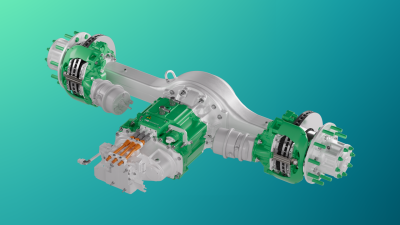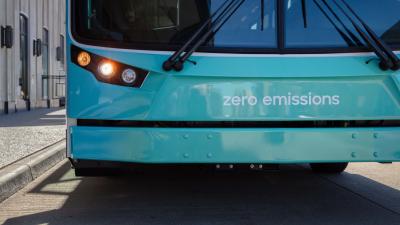ePowertrain Systems
Everything you need to know about electric axles
As businesses across the globe step up their carbon reduction efforts, many are investing in electric or hybrid vehicles. Some are fully electric, while others have electric elements, such as an electric axle (eAxle), that reduce their reliance on fossil fuels. By electrifying all or some of a vehicle’s powertrain – the components that convert fuel or electricity into power to get the vehicle moving – companies and individuals can make the switch to lower-carbon transport. Here’s what you need to know about eAxles and what the future holds for this vital component.
Modern engineering has helped us electrify many modes of transport and logistics and move away from carbon-heavy vehicles. Electric vehicles (EVs) now have the power and capacity to compete with traditional diesel-powered vehicles, with a range of performance and load-focused models that hit parity with internal combustion engine models.
Many businesses have successfully transitioned to using EVs for last-mile deliveries – but most are still working out the best business case around using EVs for long-range or heavy-goods transportation.
While EV infrastructure is improving across countries like the US, it’s not ready to support fleets of electric vehicles. One study found that, by 2035, truck stops capable of charging electric trucks will have the same power needs as a small town. And even for vehicles that can go up to 500 miles on a single charge, like Tesla’s new electric semi, the price can be incredibly prohibitive for businesses with modest budgets.
Hybrid vehicles are a more affordable and logistically realistic option for many individuals and businesses. And eAxles are one piece of equipment that is enabling a range of EV transformations – from hybrid solutions to fully electric vehicles. But what are they, exactly?
What is an eAxle?
eAxles are the most recent innovation that could change how we propel vehicles. First, let’s take a quick look at what a standard axle is, and what it does.
The standard axle is one of the key components of a vehicle. It’s one of five elements that make up a vehicle’s powertrain, which takes power from the engine or battery and delivers it to the wheels to get you moving. A standard powertrain is made up of an engine (or an electric motor for fuel cell EVs or EVs), transmission, driveshaft, differential and axles. Within the powertrain, the axle’s main jobs are to support the chassis and overall weight of the vehicle and transfer power to the wheels to propel the vehicle.
Standard axles transfer power and torque from the engine to move a vehicle in the desired direction. The first iteration was little more than a rod with two wheels attached, but modern axles offer much more control to facilitate a smooth and safe ride. All vehicles have a front and rear axle to support four wheels, but larger vehicles have more axles to support a larger chassis and a higher number of wheels. Axles are an essential part of any vehicle as they give the driver control over the direction they’re taking.
However, in the last two decades, more manufacturers have started combining the axle with different components to create a solution better suited to sustainable vehicles – the eAxle.
An eAxle is an electric drive system that integrates the necessary components required to propel a vehicle while utilizing a traditional axle structure. With gearing designed to handle high motor torque and high amounts of brake regeneration, eAxles – like the scalable Accelera offerings – can be adapted to fit various needs based on a vehicle’s application, duty cycle, and regional requirements and duty cycle.
How are eAxles powered?
eAxles take energy from battery-powered motors, which commonly use lithium-ion (Li-ion) batteries. Axles typically have one motor but, depending on how large the axle is, may have two to ensure they can deliver a sufficiently high level of energy. The latest generation of eAxles have components like the motor and transmission incorporated into one, which can weigh much less as a whole than the three separate parts.
Which motors do eAxles use?
eAxles can be powered by a range of different motor types. Some options include:
- Permanent magnet synchronous motor – PMS motors are well suited to high-performance settings thanks to their high power density and efficiency.
- Induction motor – Even though they’re comparatively low cost, and considered to be a simple and durable option, induction motors have lower efficiency and power potential.
- Switched reluctance motor – Using reluctance torque, switched reluctance motors can offer high motor-drive efficiency in a simple, low-cost motor, though they have lower torque capacity.
Electric powertrains (ePowertrains) typically have one of three motor placements: placing the motor directly into the axle, using a centralized drive solution or opting for a centralized motor with a gearbox. Opting for an integrated eAxle can reduce drag, making a vehicle more streamlined and preventing excess energy consumption.
Using fuel cells to power eAxles
Like batteries, fuel cells are also a sustainable power source for zero-emissions vehicles. To explain the technology in the simplest terms, a fuel cell has two electrodes – a negative electrode (anode) and a positive electrode (cathode) – that sit on either side of an electrolyte. The anode is fed with an energy source, which in a hydrogen fuel cell is hydrogen, and a catalyst separates the molecules into protons and electrons. The result is electricity and harmless emissions in the form of water and heat.
A hydrogen-powered fuel cell produces low or no emissions (depending on the electricity source powering the electrolysis). Hydrogen is shaping up to be a sustainable alternative for the future; while the infrastructure isn’t quite there to make hydrogen-powered vehicles a viable option at present, the technology is rapidly advancing. It’s anticipated that hydrogen-powered vehicles could be on the roads and rails en masse by 2030.
The benefits behind eAxle
eAxles could be vital in helping businesses transition from a fossil-fueled fleet to hybrid or fully electric vehicles. However, the benefits of installing an eAxle go far beyond its carbon reduction potential. These modern components come with lots of advantages, including:
- Better fleet serviceability as eAxles can be easier to integrate into a vehicle and reduce the number of separate parts.
- Potential for higher driveline efficiency with reduced gear losses.
- Increases lifespan and reduces maintenance of brakes through regenerative braking.
- Condense components usually spread throughout the entire chassis into a more compact axle.
- Frees up space to place batteries inside the frame rails in the chassis’ most protected spot. And, if more range is needed, additional batteries can be added outside the frame rails instead of conventional fuel tanks – further reducing the vehicle’s reliance on fuels.
- Reduces noise pollution because the vehicle is quieter when running.
- Facilitates an enjoyable driving experience with instant torque response.
Adapting vehicles for the future
Purchasing new vehicles is a cost many businesses cannot afford. Adapting existing trucks by fitting an eAxle is a more affordable route to make a fleet more sustainable. Some eAxles and powertrain systems, like those from Accelera™ by Cummins, have been designed with an inherently modular architecture.
Accelera™ eAxles maintain existing axle mounting hardware to make OEM integration simpler. Models like the Accelera 14Xe are suitable for a range of vehicle configurations, including electric, series hybrid and plug-in hybrid. With various transmission options for different applications, including long-range or heavy loads, our eAxles facilitate reduced fuel reliance and more sustainable transportation.

